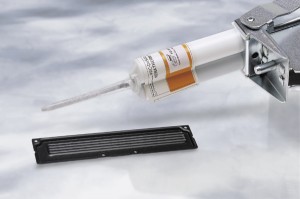
Notes and Precautions
- Silicone sealing compounds are physiologically safe
- No irritation to the respiratory system when used in sealing compounds
- Avoid contact with skin
- Silicone hardeners/curing agents are physiologically safe
- We recommend the use of protective industrial ointment
See Also: Keratherm Gap Filler Liquids
Pre-treatment:
The parts to be sealed should be dry, clean, and free of dust or grease. Avoid any solvent contamination, or condensation resulting from temperature changes. Depending on the condition of the parts to be sealed, mechanical or chemical cleaning of the surface may be necessary. An anti-static fleece or microfiber cloth should be used for this. If strongly adherent contaminants are present, a pre-softening process involving the application of an electronics/PCB cleaning agent (e.g. Loctite, Weicon, Electrolube or RC contact spray… etc.) may be required. Some cleaning agents leave an oily film on the surface that must be removed by cleaning with ethanol. The components to be coated should be aired afterwards for some time at room temperature. In some cases it may be necessary to reactivate the component surface (e.g. by means of contacting lacquers or corona treatment, etc.).
Preparation:
The GFL compounds from Kerafol® are characterized by their low viscosity of < 200 Pas. As a result, there can be a tendency for the solids contained within these compounds to settle out depending on the period of storage and the storage conditions. These 1:1 room temperature and addition-curing compounds therefore have very specific requirements with regards to processing.
Mixing:
Kerafol® supplies these GFL compounds in small 0.5 l ( 0.13 gal and 1.0 l (0.26 gal) tins as well as in a 21.5 l (5.7 gal) plastic hobbock. After opening the sealed tin or hobbock, use a suitable stirring apparatus (cross-arm agitator) or vibratory/centrifugal agitator to prepare the compound to ensure that any solids that may have settled are homogeneously dispersed again. Use moderate rotation speeds or mixing intervals when doing so. The mixing process is assisted by the thixotropic behavior of the compound. The required homogeneity has been reached when the solids are fully dispersed and no more streaks or clear silicone resin components are visible in the mixed compound. An evacuation process of max. 5 minutes at < 100 mbar (1.5 psi) should now be performed. The evacuation process is important for eliminating any entrapped air bubbles in the compound and subsequent dispensed product.
The mixed and evacuated Gap Filler Liquid compound can now be transferred to suitable processing equipment. Note that the compound still has a tendency to separate out even when processed by machine. To minimize this as far as possible, the dispensing, dosing or encapsulation machines should be cleaned on a daily basis to ensure no residues are left in the machine when not in use and not pressurized. In areas of the processing machine where residual compound remains, the compound should be pumped out every ½ hour. Any residual product in the cartridges should be disposed of after the dispensing tests have been completed. (Please note the relevant instructions in the safety data sheet).
Kerafol® supplies the Gap Filler Liquid compounds in 50 ml (1.7 fl oz), 200 ml (6.8 fl oz), and 400 ml (13.5 fl oz) double cartridges for customer samples and/or small orders. These cartridge systems cannot be re-processed.
Application:
Mixing the components in a tub:
The individual components (A + B) of the Gap Filler Liquid compounds from Kerafol® need to be added together in the specified mixing ratio (M = 1:1). Rigorously mix the components using a suitable stirrer. Ensure as little air as possible is introduced into the material. The sealing compound must now be de-aerated (this can occur in the processing equipment). This can then be followed by the actual dispensing or pouring operation. The thixotropic formulation of the compounds allows a wide range of different dispensing heights and molds to be used. Long standing times should now be avoided because the cross-linking process has commenced. Please note the specified maximum processing times. The processing time is normally max. 50 minutes. The viscosity slowly increases during this time. You should therefore only prepare as much material as you can process during this time.
Dosing units:
When using cartridge material, it is no longer necessary to evacuate the material after the mixing process in the mixing nozzle because the components are dispensed free of air bubbles. When using material from a hobbock, the material must be vented after mixing or pumping into the supply tank of the dosing unit. The material is now ready to apply.
It is possible to optimize the processing time (normally max. 50 min) for the dosing and handling process. (The processing and cross-linking time of the GFL compounds can, by special request, be modified if ordering suitably large volumes). Processing of the compound beyond this time should be avoided as the processing conditions will continuously change during the cross-linking stage (rise in viscosity, viscidity of the sealing compound, etc.).
After dispensing the compound over an area or into a volume, it should be allowed to rest while the cross-linking process takes place. The required rest period is 120 minutes from the start of application. Post-application drying at higher temperatures can greatly reduce the required rest period. The applied compound should not, however, be subjected to temperatures above + 60 °C (140°F).
Curing Conditions:
Room temperature cross-linking systems: The standard cross-linking time is 60 minutes at room temperature (18 °C / 65 °F– 25 °C / 77°F). The pot life is between 10 and 20 minutes of the total cross-linking time depending on the particular GFL compound (see also the data sheets of the individual compounds). The handling time (time until the next processing step) for GFL compounds is between 40 and 50 minutes. When curing at room temperature, note that it is possible to increase the hardness of the compound somewhat by subjecting it to a heat treatment. Please note also the specific value indicators on the data sheets. Before further processing (final assembly, packaging and transport, etc.), allow a standing time of twice the cross-linking time to ensure cross-linking is complete. Increasing the temperature by a moderate amount (max. + 60 °C / 140°F ) can affect the cross-linking time. Specific data for the individual materials is available on request. GFL compounds crosslinked at room temperature should stay 3 – 4 days before fully utilized mechanically and electrically.
Shelf Life:
The GFL compounds have a shelf life of at least 12 months in the original container and under normal frost-free conditions: [room temperature + 5 °C / 41°F – to + 40 °C / 104°F with a rel. humidity of 30 – 70%].
GFL sealing compounds will only be supplied in cartridges on an individual order basis, and need to be processed in the shortest possible time (view Table 1). The cartridges should be stored vertically (dispensing tip downwards) and in a cool location (at approx. 8°C / 46°F– 12 °C / 54°F). Additionaly we suppose a rolled storage for 1 component cartridges.
After opening a container, you should use the contents as soon as possible as the reactivity can decrease over time due to the influence of humidity.
We do not recommend storing 50ml cartridges of GFL sealing compound as the contents of the cartridge may exhibit settling or bleeding due to the low viscosity of the materials.
Transport conditions:
Clean, free of dust and moisture at min. – 40 °C to max. + 60 °C; Make sure there is no condensation on the material before processing!




